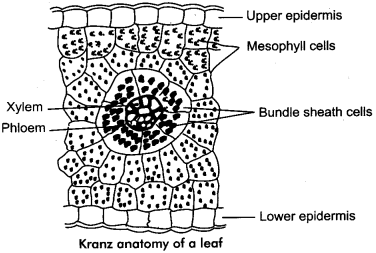(a) Kranz anatomy: On the basis of internal structure of leaves, C3 and C4 plants can be distinguish separately. The leaves of C4 plant possess Kranz anatomy. In such leaves, the mesophyll is not differentiated into palisade and spongy tissue. In such leaves, the vascular bundle sheath cells are comparatively large in size, more in number and without or less grana, while the chioroplasts of mesophyll cells have well developed grana. Thus chioroplasts in C4 leaves are dimorphic. The enzyme of Calvin cycle are found in bundle sheath cells only.

(b) Chloroplast: The process of photosynthesis take place in chloroplast. Chloroplasts are mainly found in mesophyll cells. The mesophyll cell may contains upto 300 hundred chloroplasts. In higher plants, chloroplasts may be oval, spherical or discoid in shape. Chloroplasts mainly found in leaves but they are also present in other parts of plants such as leaf petiole, pedicel, herbaceous stems, calyx and other green parts. They also carry on photosynthesis. But the process of photosynthesis mainly takes place in leaves.
Structure of Chloroplast: In higher plants chloroplasts are disc-shaped or lens-shaped. They are generally 4 - 10 pm in diameter and 1 - 3 pm in thickness. Each chloroplast is surrounded by two unit membrane of lipoprotein which are called outer and inner membranes. These membranes are smooth and selectively permeable. Intermembranous speace is present between these two membranes. There two systems are found inside these membranes called stroma or matrix and grana or lamellar system.

(c) Chemiosmotic hypothesis: According to this theory, molecules like glucose are metabolized to develop acetyl CoA in the form of an intermediate that is energy-rich. The proper oxidation of acetyl CoA occurs in the mitochondrial matrix and is combined to the reduced form of a carrier molecule namely FAD and NAD. The carriers then supply electrons to the transport chain of the electron in the inner membrane of mitochondria, which further supply them to different other proteins present in the ETC. The energy present in the electrons is basically used to pump out protons from the matrix in the inner mitochondrial membrane. It is used for energy storage in the form of a transmembrane electrochemical gradient.
The protons return to the inner membrane by the ATP enzyme synthase. The proton - flow travels into the matrix of mitochondria through ATP synthase, which gets a good amount of energy for the ADP to integrate with inorganic phosphate to produce ATP.